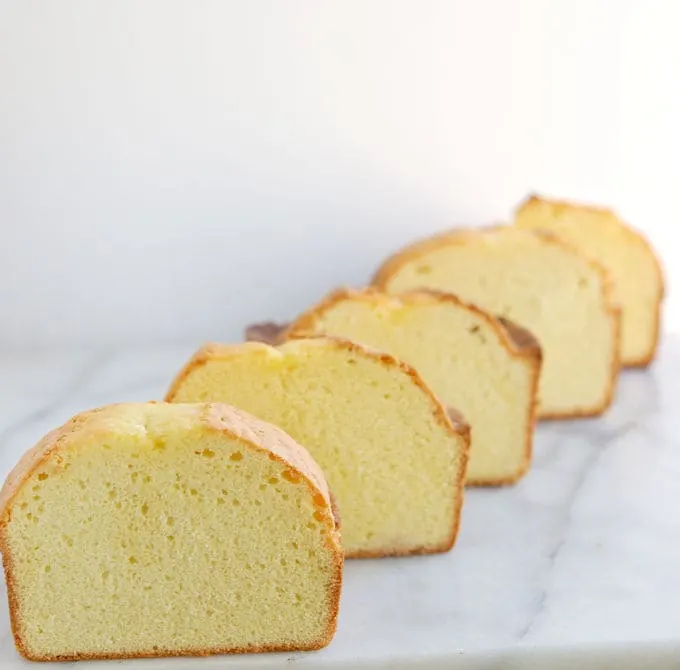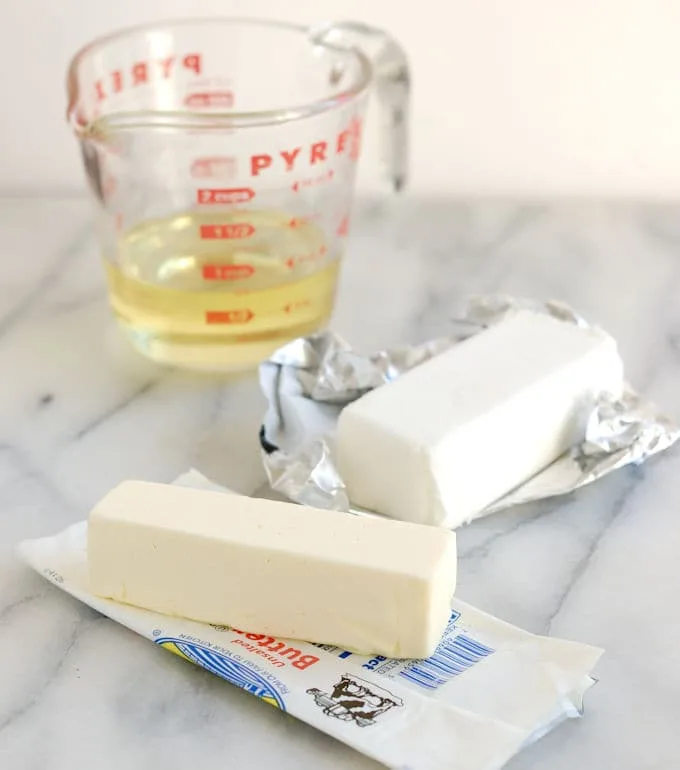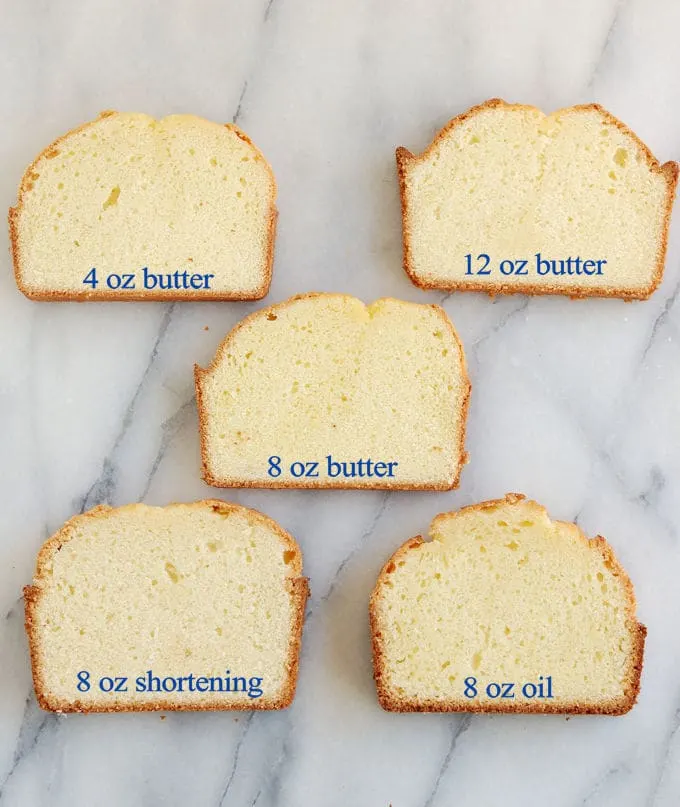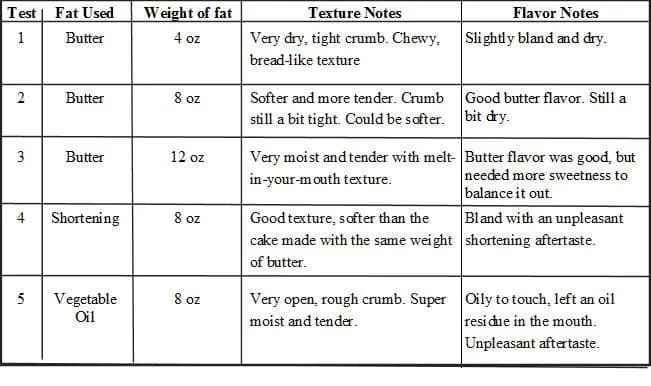The Function Butter & Other Fats in Cake Batter
Welcome to class #6 of 7 in the “Cake Batter” course. This article will explore another ingredient in cake batter, butter and other fats.

To learn general information about the science of butter and other fats please visit the Baking Ingredients – Butter & Other Fats page. This class is specifically about butter and fats in pound cake batter.
The ingredients that strengthen the cake structure (flour and eggs) need to be balanced with the ingredients that weaken the cake structure (sugar and fat).
To create a moist, sweet and tender cake that bakes up with a nice even crumb the four main ingredients have to work together.

What butter and fat does in Cake Batter
Fat acts as a tenderizer in cake batter. First, because it adds moisture and richness to the cake and, second, because fat interferes with gluten formation in the flour and with coagulation of the eggs.
Solid fats, like butter and shortening, are also the vehicle for creating air pockets in the cake batter. A light and airy cake will fall apart more easily in your mouth, which creates an impression of tenderness.
The three main fats used in cake batter are butter, shortening and oil. Certain fruit purees can also used to replace some or all of the fat in some cake recipes.
Lets look at each and find out the advantages and disadvantages.
Testing different fats in cake Batter:
I baked 5 pound cakes using various amounts of butter, shortening and vegetable oil. Otherwise I kept to the traditional quatre quarts recipe, using of 8 oz of each ingredient.


So, as I pretty much already knew even before running the tests, for a pound cake, butter is the only way to go.
Using oil, shortening and even fruit purees can work in other cake recipes, but not for pound cake.
Other cake batter classes:
Next up: The Cake Recipe Formula
- Reverse Creaming
- The function of flour in cake batter
- The function of eggs in cake batter
- The function of sugar in cake batter
- The function of salt and baking powder in cake batter
When we’re done experimenting with all the ingredients for this “cake batter” course, we’ll use all we’ve learned to create Pound Cake Perfection.


Hi! Thanks for this post! I’ve also tried using butter vs oil, and found that the cake with butter was indeed softer and less dense. Which brings me to the question, are pound cakes meant to be soft? or dense? thought the softer loaf leans more towards a sponge cake? but not quite like a chiffon… haha if you could help with what exactly a pound cake’s texture should be like?:)
I think a pound cake should be soft and “dense”, but dense in a good way. A good pound cake should have a small, even crumb that melts in your mouth. A sponge or chiffon cake is soft, but with an open crumb. Both types of cake are nice, just different. Because pound cake is meant to be served without icing, the cake should have plenty of richness from the butter. Here’s my recipe for Perfect Pound Cake.
Greetings! I was talking with my wife and telling her that I’ve never been satisfied with the pound cakes I’ve baked. There’s always something wrong with them. I told her I wanted to “gain a name” for baking the best pound cake in the neighborhood. She reminded me that at my age (73), just being known to be alive and breathing is accomplishment enough. Anyway, I started looking on the web for helpful hints and found your website. I went through the 7 lessons, and today, being as careful as I could, I weighed out everything by grams and baked my first pound cake using your recipe. It is one of the best cakes I’ve made, and I wanted to thank you for putting the lessons and recipe together. A few more cakes and I’ll have the basics down, then I’m going to start experimenting. One quick question, is there someplace on your site that would give me some guidelines in adding fruit and cream cheese to a pound cake recipe? That’s one cake I’d love to bake.
Thank you again, you’ve made this old duffer a happy camper.
Hi Paul, glad you’re enjoying baking at 73 years young. As far as adding in fruit and cream cheese; Cream cheese is pretty. At some point I do plan to post a cream cheese pound cake recipe, just haven’t had time to do the testing yet. But I would start with the butter and milk in the Perfect Pound Cake recipe. Replacing some of the butter and the milk with cream cheese would be the place to start. Fruit is a bit trickier since you’re adding water, acid, fiber and other stuff. Something like blueberries is easy since you can just fold them in. But I’ve had a devil of a time adding something like strawberries or peaches, which have lot and lots of water.
@Paul Gardner, you can replace the milk with cream cheese.
Hi Eileen, I recently baked my first sourdough bread from my own starter following your directions. The taste was fabulous but I was disappointed in it’s rising. The bread was moist and kind of flat. I was wondering what you think I did wrong. Also I was wondering about the initial kneading of the bread with the hook. How long should I be kneading the bread initially. I took a bread course before that instructed me to stretch the dough and it should form a window that does not break. Any feedback would be greatly appreciated. I love your teaching and recipes. Celia
I have found cake recipes using 35% fat whipping cream… how is this compared to butter and cake texture?? Thanks
As long as the recipe is balanced, adding whipped cream can give a cake a lovely texture. I use whipped cream in my Strawberries & Cream Bundt cake.
How does the cake react to salted vs unsalted butter?
There wouldn’t be much of a difference, but I would omit the salt in the recipe since there is salt in the butter.
@Eileen,
Hi…pls what of magarine as a substitute for butter
Depends on the margarine. It will act differently than butter since it usually has more water and less fat. Stick margarine will be different than a soft tub margarine.